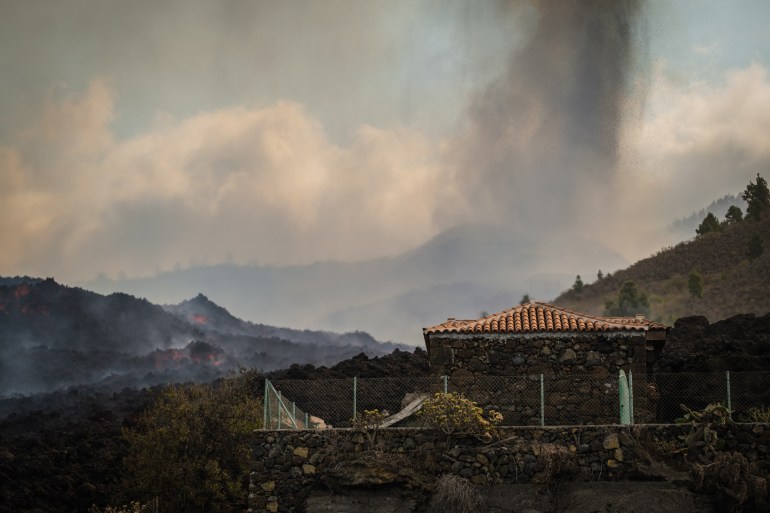The authorities of the island of "La Palma" - belonging to the Spanish archipelago of the Canary Islands - decided to raise the level of alert to red, after the eruption of the volcano "Combre Vieja" on the island.
The local authorities reported that the explosion created holes in the ground, which contributed to the release of lava that reached some towns that were evacuated from the population in anticipation, as the lava destroyed about 100 houses on its way.
On Sunday afternoon, 5,000 people have been evacuated since the eruption of the volcano.
And the regional authorities in the Canary Islands indicated - on Twitter - that they do not intend at the current stage to conduct new evacuations, explaining that the lava is heading "toward the sea."
Lava destroyed on its way to about 100 homes (French)
Lava
Videos circulated on social media showed massive lava flows that fell on trees, completely inundated roads and swept into homes through open windows.
In a statement to state television, TVE, Mariano Hernandez Zapata, mayor of La Palma, spoke of the ruin left by lava, "about 6 meters high (...) that swallowed almost everything that was found in its path."
According to the Canary Islands Institute of Volcanology, the lava is advancing at a speed of 700 meters per hour, and its temperature is about 1,000 degrees Celsius.
No casualties have yet been reported from the eruption of the volcano, the first on the island of La Palma in 50 years.
In a statement to Agence France-Presse, Lorena Hernandez Labrador, the municipal councilor of "Los Llanos de Eridani", said that the lava led to the destruction of "100 homes in the towns of Los Llanos, El Paso and Tatacorte."
Homes near the volcano have been evacuated (Anatolia)
Evacuation and fear
Angie Chu, 27, who lives a few kilometers from the volcano in Los Llanos de Aridani, said she had only "3 minutes" to vacate her house at 4:30 am with her husband and 3-year-old child.
And she added that we were not at home when the volcano erupted, and added, "We wanted to return, but the roads were closed, and the police allowed us to pass, but they told us you have 3 minutes" to evacuate and bring the "emergency bag" that the authorities asked the residents to prepare.
Yahira Garcia, 34, who lives at the foot of the volcano, was able to bring clothes, a TV, a computer and some souvenirs before evacuating her home with her husband in two cars.
And she - the thirties, who "has not closed her eyes for two days" - said that her house was shaking greatly, and I thought it would collapse, and added that "the scenes are harsh, and we do not know when we will return" to our house.
The history of the last volcanic eruption on the island of "La Palma" dates back to 1971 (Anatolia)
Monitor and forecast
The Cumbre Vieja volcano has been closely monitored for a week due to the significant increase in seismic activity, and it erupted on Sunday shortly after 15:00 local time (14:00 GMT).
The amount of lava is estimated at between 17 and 20 million cubic meters, according to the president of the Canary Islands, Angel Victor Torres, who warned in a video clip posted on Twitter that the eruption “will continue” for this reason, although all indications - according to the technical committee - indicate that there is no Lava continues to flow.
And Prime Minister Pedro Sanchez - who was supposed to leave for New York to attend the work of the United Nations General Assembly - decided to go immediately to the island, which he arrived on Sunday evening to follow up on developments in the situation and ongoing operations.
According to the scientific coordinator of the Institute of Volcanological Sciences of the Canary Islands, Nemesio Perez, volcanic activity can last "several weeks, even a few months";
Due to the presence of a second pocket of magma at a depth of between 20 and 30 km.
It is noteworthy that the history of the last volcanic eruption on the island of "La Palma" dates back to 1971.
The population of this island (which is one of the seven islands in the archipelago located off the coast of northwest Africa) is about 85,000 people.
The last volcanic eruption was recorded in the Canary Archipelago in 2011, and it occurred under water in the range of El Hierro Island.

